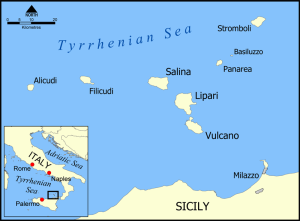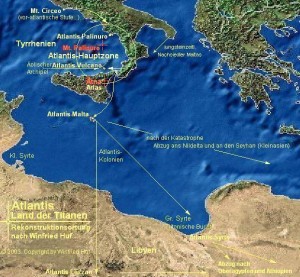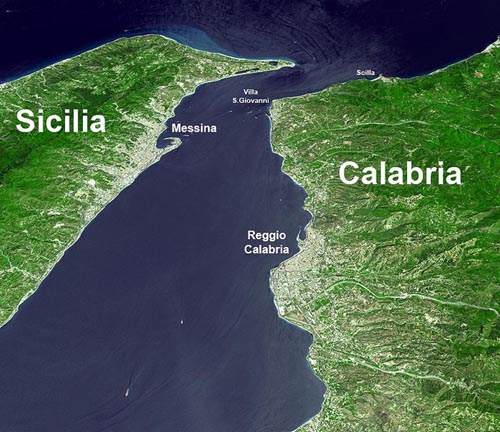Winfried Huf
Syrtis
Syrtis was the name given by the Romans to two gulfs off the North African coast; Syrtis Major which is now known as the Gulf of Sidra off Libya and Syrtis Minor, known today as the Gulf of Gabes in Tunisian waters. They are both shallow sandy gulfs that have been feared from ancient times by mariners. In the Acts of the Apostles (Acts 27.13-18) it is described how St. Paul on his way to Rome was blown off course and feared that they would run aground on ‘Syrtis sands.’
However, they were shipwrecked on Malta or as some claim on Mljet in the Adriatic.
The earliest modern reference to these gulfs that I can find in connection with Atlantis was by Nicolas Fréret in the 18th century when he proposed that Atlantis may have been situated in Syrtis Major. Giorgio Grongnet de Vasse expressed a similar view around the same time. Since then there has been little support for the idea until recent times when Winfried Huf designated Syrtis Major as one of his five divisions of the Atlantean Empire.
However, the region around the Gulf of Gabes has been more persistently associated with aspects of the Atlantis story. Inland from Gabes are the chotts, which were at one time connected to the Mediterranean and considered to have been part of the legendary Lake Tritonis, sometimes suggested as the actual location of Atlantis.
In the Gulf itself, Apollonius of Rhodes placed the Pillars of Herakles(a) , while Anton Mifsud has drawn attention[0209] to the writings of the Greek author, Palefatus of Paros, who stated (c. 32) that the Columns of Heracles were located close to the island of Kerkennah at the western end of Syrtis Minor. Lucanus, the Latin poet, located the Strait of Heracles in Syrtis Minor. Mifsud has pointed out that this reference has been omitted from modern translations of Lucanus’ work!
Férréol Butavand was one of the first modern commentators to locate Atlantis in the Gulf of Gabés[0205]. In 1929 Dr. Paul Borchardt, the German geographer, claimed to have located Atlantis between the chotts and the Gulf, while more recently Alberto Arecchi placed Atlantis in the Gulf when sea levels were lower(b) . George Sarantitis places the ‘Pillars’ near Gabes and Atlantis itself inland, further west in Mauritania, south of the Atlas Mountains. Antonio Usai also places the ‘Pillars’ in the Gulf of Gabes.
In 2018, Charles A. Rogers published a paper(c) on the academia.edu website in which he identified Tunisia as Atlantis with it capital located at the mouth of the Triton River on the Gulf of Gabes. He favours Plato’s 9.000 ‘years’ to have been lunar cycles, bringing the destruction of Atlantis into the middle of the second millennium BC and coinciding with the eruption of Thera which created a tsunami that ran across the Mediterranean destroying the city with the run-up and its subsequent backwash. This partly agrees with my conclusions in Joining the Dots!
Also See: Gulf of Gabes and Tunisia
(a) Argonautica Book IV ii 1230
(c) https://www.academia.edu/36855091/Atlantis_Once_Lost_Now_Found?auto=download*
Strait of Messina
The Strait of Messina is, at its narrowest point, just 2 miles wide. A number of classical writers refer to a time when Sicily was still connected to Italy. In fact legend has it that Heracles was responsible for their separation. However, Cyprian Broodbank has pointed out in his monumental work, The Making of the Middle Sea, that “Today, the Messina strait dividing it (Sicily) from peninsular Italy is a minimum of 3 km (2 miles) wide and 72 metres (235 ft) in depth at its shallowest point. On the face of it, therefore, Sicily and mainland Italy should have fused under full glacial conditions. Yet this spot lies on a plate boundary and has already risen several metres over the last 150 years for which accurate measurements exist. Add a 127,000-71,000-year-old beach now elevated 90m (300ft) above the sea near the strait and we might start to wonder whether Sicily was ever solidly attached to the other land.”[1127.91] Nevertheless, he does suggest that early man possibly had stepping-stones in the form of islets and shallows between the two landmasses.
The Strait of Messina had a reputation in antiquity for having dangerous currents, which are thought to be the inspiration for Homer‘s sea monsters, Scylla and Charybdis. Heinrich Schliemann supported this identification[1243]. The currents there are still very dangerous, but nevertheless the strait is a busy waterway with both commercial and pleasure craft, indicating that the conditions there can be mastered. The hazards were situated at the northern end of the Strait, where today there is a town appropriately called Scilla on the Calabrian side.
The strait is sometimes offered as an earlier site for the Pillars of Heracles prior to the Western Mediterranean becoming more frequently navigated by the ancient Greeks, at which time the term was transferred to the Strait of Gibraltar. Winfried Huf is a keen supporter of ‘Pillars’ having been located at Messina. A constituent part of the Western Mediterranean was the Tyrrhenian Sea, which, for the Greeks, would have been most easily accessed through the Strait of Messina.
The earliest westward expansion of the Greeks was understandably to what became known as Magna Graecia in Sicily and southern Italy. The Phoenician expansion was along the north African coast eventually establishing Carthage at the Strait of Sicily. The ships available at that time were not designed for the open sea, but were usually kept within sight of land. I am inclined to think that the early Greeks would have had the Strait of Messina as the location of their Pillars of Heracles leading to the little known Western Mediterranean (or Tyrrhenian Sea), apparently referred to by some as the ‘Atlantic Sea’, whereas the Strait of Sicily might have led to conflict with the Phoenicians!
It is interesting that from around 330 BC and for nearly a thousand years(b) the Strait of Messina was known as Fretum Siculum, which translates as the Sicilian Strait. Philo of Alexandria (20 BC-50 AD) in his On the Eternity of the World(c) wrote “Are you ignorant of the celebrated account which is given of that most sacred Sicilian strait, which in old times joined Sicily to the continent of Italy?” (v.139).
>Alexander V. Podossinov in his paper on straits and their significance for the ancients commented “the Carthaginians for a long time did not permit the Greeks to pass through the Straits of Messina and had power over the whole western Mediterranean.”(d)<
Support for the idea of the Western Mediterranean being the ‘Sea of Atlantis’ with the ‘Pillars’ at the Strait of Messina is presented on a French forum(a), which offers the map below.
(a) https://histoiresecrete.leforum.eu/t716-quelques-questions-se-poser-sur-le-Tim-e-Critias.htm
(b) https://pleiades.stoa.org/places/462494
Lipari Islands
The Lipari or Aeolian Islands are located northeast of Sicily. The archipelago  includes the continually active volcano of Stromboli. It was another of the islands, named Vulcano after Vulcan, the Roman god of fire, which gave us the word ‘volcano’.
includes the continually active volcano of Stromboli. It was another of the islands, named Vulcano after Vulcan, the Roman god of fire, which gave us the word ‘volcano’.
>Another of the group, called Panarea, has hot gases escaping from a magma chamber that turns “the surrounding waters so corrosive that ancient Romans mariners moored their ships here to cleanse barnacles from the hulls.(d)“<
The group of islands is the preferred location for Atlantis by writers such as Winfried Huf and Vlaceslav Jurikov.
It appears that the claim by Jurikov may have been a hoax according to a report on the atlantisforshung.de website!(c)
Further information regarding the extent of this archipelago from the time of the Last Glacial Maximum is available on the mapmistress website(b).
Volcanic pumice from the archipelago has been identified as far away as Egypt and dates to the 18th Dynasty(a).
(a) https://publik.tuwien.ac.at/files/PubDat_176233.pdf
(b) Lipari & Vulcano: Aeolian Islands (archive.org)
(c) https://atlantisforschung.de/index.php?title=Vlaceslav_Jurikov
(d) National Geographic June 2023 p.65 *
Huf, Winfried
 Winfried Huf is from the southern Tyrol. He contends that the centre of Atlantis lay in the region of the Lipari Islands north east of Sicily. He maintains that the Atlantean Empire was divided into five principal sectors; The Lipari Islands, mainland Italy, Malta, Syrtis Major and Fezzan in south-east Libya. Huf identified the nearby Strait of Messina as the location of the Pillars of Heracles.
Winfried Huf is from the southern Tyrol. He contends that the centre of Atlantis lay in the region of the Lipari Islands north east of Sicily. He maintains that the Atlantean Empire was divided into five principal sectors; The Lipari Islands, mainland Italy, Malta, Syrtis Major and Fezzan in south-east Libya. Huf identified the nearby Strait of Messina as the location of the Pillars of Heracles.
Huf has accepted Plato’s 9,000 ‘years’ as being literally solar years rather than the competing and more credible theory of them being a reference to lunar cycles. He traces evidence of Atlantis in Homer, the Persephone myth, Genesis and the Norse Eddas.
Huf’s views are available on the Internet(a), although in German, they can be read in English with a good translator. Huf has written a similar paper(b) about Homer’s Odyssey.
(a) https://web.archive.org/web/20140106174902/https://www.psilog.info/Atlantis.html (German)
*(b) https://web.archive.org/web/20140106162941/https://www.psilog.info/Odyssee.html*


